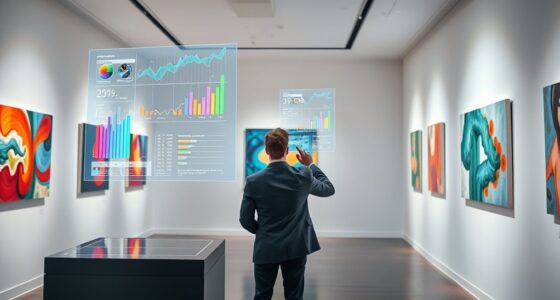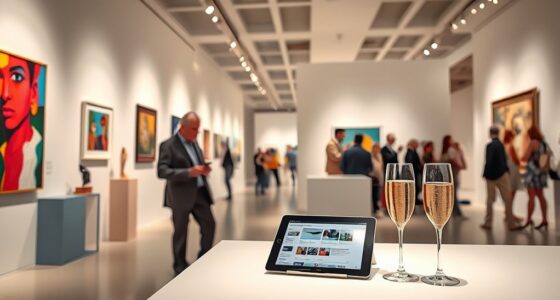By 2025, blending online art sales with in-person fairs will help you reach wider audiences and deepen engagement. Use digital marketing, virtual tours, and interactive technologies to showcase your work globally, while maintaining personal connections through in-person events. A combined approach allows you to adapt to evolving preferences and build a loyal community. If you want to discover effective strategies to make this balance work for you, there’s more to explore ahead.
Key Takeaways
- Blended strategies leverage online platforms for wider reach while maintaining the personal touch of in-person fairs.
- Virtual tours and interactive sessions enhance online engagement, complementing physical event experiences.
- Consistent branding and storytelling across digital and offline channels foster strong audience connections.
- Data analytics inform tailored marketing efforts, optimizing both online sales and in-person attendance.
- Combining digital tools with traditional events creates a dynamic, flexible approach to art discovery and sales in 2025.

In recent years, the way art enthusiasts discover and purchase artwork has shifted dramatically, with online sales gaining ground alongside traditional in-person fairs. As a seller or gallery owner, you need to adapt your strategies to stay relevant in this evolving landscape. Digital marketing plays a pivotal role here, offering you powerful tools to reach a broader audience and foster deeper engagement. By leveraging targeted social media campaigns, email newsletters, and search engine optimization, you can showcase your artworks to potential buyers worldwide. These methods allow you to tell compelling stories about your pieces, making them more appealing and memorable. Engaging your audience online isn’t just about visibility; it’s about creating meaningful interactions that build trust and loyalty. You can host live virtual tours or Q&A sessions, giving viewers a behind-the-scenes look at your creative process or upcoming exhibitions. This approach humanizes your brand and encourages viewers to connect emotionally with your art, increasing the chances of a sale. Moreover, analytics tools help you understand what resonates with your audience, enabling you to refine your messaging and content for maximum impact. Audience engagement becomes a two-way street when you actively respond to comments, messages, and inquiries. This responsiveness demonstrates that you value your viewers’ interest and opinions, fostering a sense of community around your work. In the digital space, every interaction counts, and personalized communication can turn casual browsers into loyal collectors. As online platforms grow more sophisticated, integrating virtual reality or 3D viewing options can enhance engagement, giving buyers a more immersive experience of your artwork. These innovations make it easier for someone miles away to feel confident in their purchase, reducing hesitation and increasing sales. Additionally, understanding the importance of content formats and their impact on engagement can help tailor your online presence more effectively. While in-person fairs offer tactile experiences and personal connections, online sales expand your reach exponentially. Using digital marketing strategically ensures that your audience engagement remains strong across both channels. In 2025, blending these approaches will be essential, allowing you to maximize your visibility and sales potential. The key is to maintain a consistent brand voice across all platforms and keep your audience engaged with fresh content, interactive events, and timely responses. Whether in a physical gallery or an online marketplace, your ability to connect authentically with your audience will determine your success. Embracing a blended strategy means you’re not just selling art; you’re creating a dynamic community of collectors and enthusiasts eager to discover and support your work.
Frequently Asked Questions
How Can Artists Effectively Balance Both Online and In-Person Sales?
You can effectively balance online and in-person sales by implementing consistent branding across platforms and adopting flexible pricing strategies. Showcase your art in both spaces with a unified style, making your brand recognizable everywhere. Adjust your pricing based on the venue and audience, offering discounts or exclusive pieces for in-person fairs or online promotions. This approach helps you reach diverse buyers while maintaining a cohesive, professional presence.
What Technological Tools Enhance Blended Art Sales Strategies?
Think of technology as your art gallery’s secret weapon. Use virtual galleries to showcase your work globally, making it accessible anytime. AI curation tools help highlight your best pieces, attracting the right buyers effortlessly. These tools streamline your sales process, keeping your art in front of audiences both online and in person. Embrace virtual platforms and AI curation to create a seamless, engaging experience that turns browsers into buyers.
How Do Customer Preferences Differ Between Online and In-Person Art Buyers?
You’ll notice online art buyers prioritize convenience and detailed collector insights, often seeking easy access to artwork and transparent purchasing motivations. In contrast, in‑person buyers value the tactile experience, personal connection, and immediate feedback. Understanding these differences helps you tailor your strategy, offering detailed online descriptions for digital buyers and immersive, face-to-face interactions for those attending fairs, ultimately aligning with their unique purchasing motivations.
What Are the Key Challenges in Integrating Online and Offline Art Markets?
Imagine weaving a tapestry where digital infrastructure is the loom and market segmentation the threads. The key challenges lie in synchronizing these strands seamlessly, ensuring the online and offline worlds connect smoothly. You must navigate differing customer expectations, maintain consistent branding, and adapt to evolving technologies. Balancing these elements requires strategic finesse, so your art resonates across both spheres, creating a harmonious blend that captivates all audiences.
How Will Emerging Trends Influence Art Sales Strategies in 2025?
Emerging trends like digital galleries and virtual auctions will reshape your art sales strategy in 2025. You’ll find more opportunities to reach global buyers, making online sales more interactive and engaging. You should leverage these trends by integrating immersive digital experiences and hosting live virtual auctions, which will attract new collectors and boost your sales. Staying adaptable and embracing technology will be key to thriving in this evolving art market landscape.
Conclusion
By blending online sales with in-person fairs, you open a powerhouse strategy for 2025. Don’t underestimate the reach of a well-crafted website—it’s your digital gallery that can rival the Louvre. Pair that with lively fairs, and you’re creating an unstoppable art empire that captures hearts and wallets alike. Embrace this hybrid approach, and you’ll turn your art career into a force so mighty, it could shake the very foundations of the art world!









